
Process Improvement through Documentation
|
October 16, 2025
|
10 Process Documentation Examples to Streamline Your Operations
Overview
You might be wondering how to make your operations run smoother. Well, this article has got you covered with ten fantastic examples of process documentation tools that are all about streamlining your workflow. Tools like SowFlow, Miro, and Lucidchart are here to help, each bringing its own unique features, like automation, visual collaboration, and centralized knowledge management, to the table.
These tools tackle common headaches we all face, like scattered data and poor communication. By addressing these issues, they can really boost productivity and make your team’s operations much more effective. So, why not dive in and see how these tools can transform your work life?
Key Highlights:
- SowFlow enables instant creation of process documentation, enhancing knowledge management and reducing chaos.
- 42% of staff struggle with information sharing due to fragmented data, underscoring the need for efficient record-keeping solutions.
- The document management systems market is projected to grow significantly, indicating rising demand for tools like SowFlow.
- 70% of team members believe fewer meetings and emails could boost productivity, highlighting the need for streamlined communication.
- Miro facilitates visual collaboration for process documentation, improving understanding and engagement among team members.
- 41% of employees find inter-departmental collaboration challenging, making Miro's capabilities essential for effective communication.
- SowFlow automates the creation of step-by-step onboarding guides, improving efficiency and accessibility for new employees.
- Document360 offers a centralized knowledge base with features like version control, enhancing knowledge sharing and operational effectiveness.
- Whatfix provides digital adoption tools that support employees in navigating new processes, improving training efficiency.
- Lucidchart allows for clear visualization of workflows, boosting communication and identifying bottlenecks in processes.
- Asana serves as a project management tool that enhances workflow documentation, ensuring accountability and clarity in task management.
- Trello uses a visual approach to manage tasks, improving collaboration and organization within teams.
- Confluence supports real-time collaboration and record-keeping, leading to increased customer satisfaction and operational efficiency.
- Notion offers flexible documentation and project management capabilities, promoting organized record-keeping and continuous improvement.
Introduction
In the fast-changing world of business operations, you might be wondering: how important is effective documentation really? Well, it’s become a cornerstone of success for organizations aiming to boost efficiency and streamline their processes. Innovative tools are shaking things up, transforming how teams create, manage, and share their documentation. Think about platforms like SowFlow that let you map out processes in a snap, or collaborative solutions like Miro and Confluence that encourage teamwork. The modern workplace is embracing all sorts of technologies to tackle the challenges of information management.
Now, here’s something to consider: a lot of employees struggle to find and share essential data. That’s why the need for user-friendly documentation solutions is more pressing than ever. In this article, we’ll explore some cutting-edge tools that not only make documentation easier but also empower teams to boost productivity and operational effectiveness in today’s competitive environment. So, let’s dive in and discover how these tools can help you and your team!
SowFlow: Instant Creation of Process Documentation for Enhanced Efficiency
You might be wondering how to make sense of the chaotic information landscape in your business. Well, SowFlow is here to help! It transforms the way you generate —instantly. With its intuitive interface and advanced technology, your team can easily map workflows and standard operating procedures (SOPs), ditching those old, time-consuming methods. This streamlined approach not only cuts down on the chaos but also serves as a process documentation example, enhancing your knowledge management and making it easier to keep your records precise and up-to-date. In fact, 42% of staff report struggles with finding and sharing information due to fragmented data. This highlights just how crucial efficient record-keeping solutions are! Plus, the document management systems market is projected to grow from $7.16 billion to at least $24.91 billion by 2032. Clearly, there’s a rising demand for tools like SowFlow that provide immediate record-keeping.
Speaking of productivity, did you know that 70% of team members believe fewer meetings and emails could really boost their output? It just goes to show how important streamlined communication is for operational efficiency. However, 27% of companies still face rising costs as a barrier to going paperless. That’s where economical solutions like SowFlow come into play.
And let’s not forget about the recent advancements in generative AI! These innovations allow for quick training of custom document models, helping businesses adapt to specific needs on the fly. This makes SowFlow even more relevant in today’s fast-paced environment. So, why not explore how it can simplify your documentation challenges?
Miro: Visual Process Mapping for Collaborative Documentation
You might be wondering how to make collaboration easier for your team. Well, let me introduce you to Miro! It’s a fantastic visual collaboration platform that really shines when it comes to creating intricate process documentation examples and diagrams. With its user-friendly interface, team members can brainstorm and visualize workflows together in real-time, making it a breeze to work collectively.
Now, here’s something to think about: did you know that 98% of employees often feel dissatisfied with video meetings from home? That’s where effective collaboration tools like Miro come into play. By using Miro, organizations can seriously boost their record-keeping processes, providing a process documentation example that turns complex information into formats that are easy to digest. This visual approach not only enhances understanding but also encourages everyone in the group to engage in the recording process actively.
Speaking of collaboration, have you noticed how 41% of employees find it tougher to collaborate across departments than within their own teams? That’s why Miro’s capabilities are so crucial for promoting effective communication and coordination across different functions. And let’s not forget the staggering fact that cost the U.S. about $1.9 trillion in lost productivity each year! So, by leveraging Miro, operations managers can improve employee engagement and operational efficiency. It’s definitely worth considering!
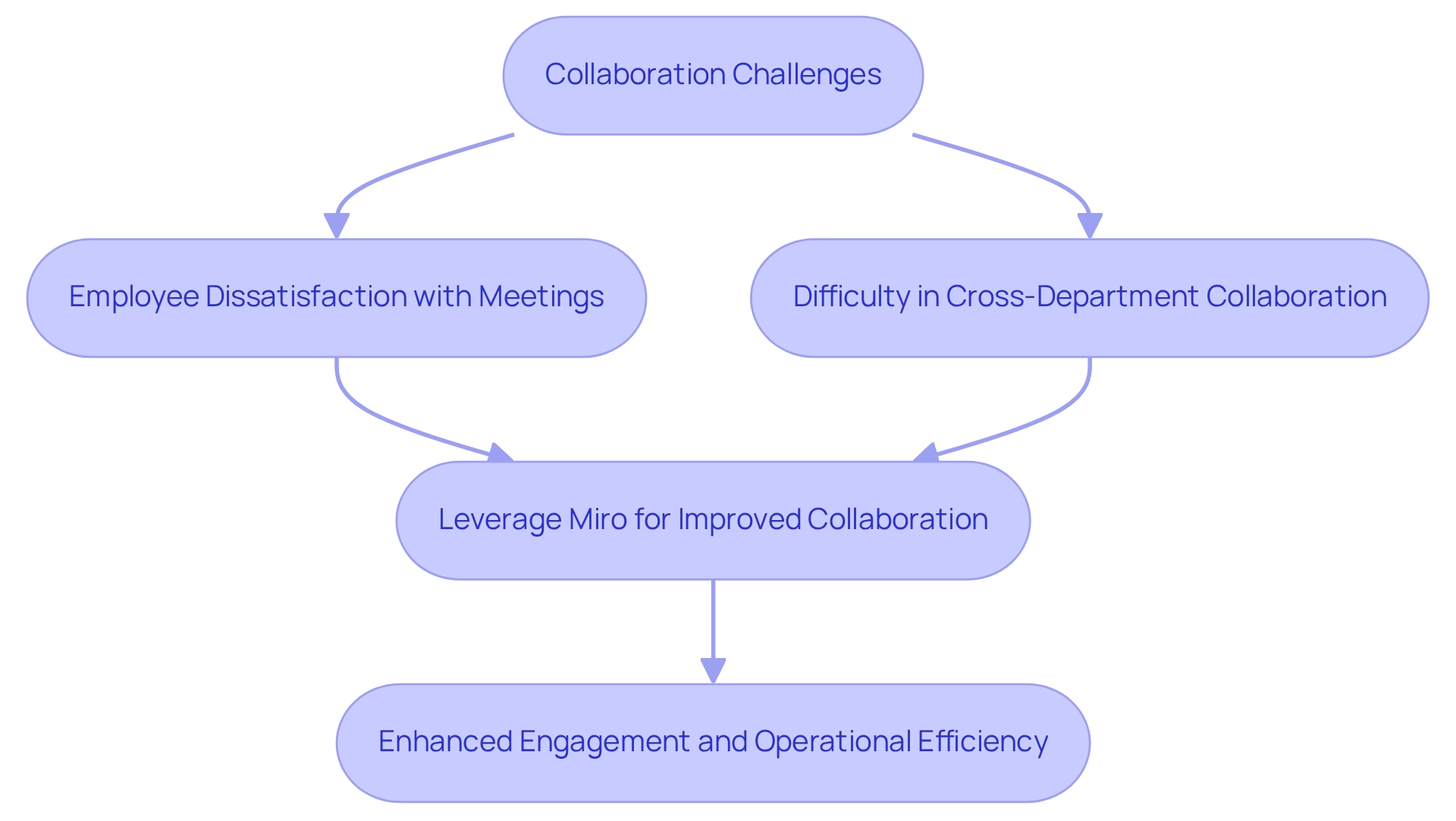
Scribe: Effortless Step-by-Step Guide Creation for Onboarding
You might be wondering how to make onboarding new employees smoother and more effective. Enter SowFlow, which is changing the game by providing for creating step-by-step guides. This tool automatically records activities in real-time, generating clear and concise records that you can easily share with new hires. Not only does this speed up the onboarding process, but it also ensures that new team members have instant access to the essential information they need to hit the ground running from day one.
Now, let’s dive into how SowFlow makes life easier for your team. Files are effortlessly saved in your team’s workspace, giving everyone instant access to the right materials. This is crucial for sharing workflows effectively. By leveraging SowFlow, companies can boost their onboarding efficiency and develop a process documentation example that cultivates a more engaged and informed workforce. Plus, the intuitive guidance solutions provided by SowFlow really enhance the overall employee experience during training. So, why not give it a try and see how it can transform ?
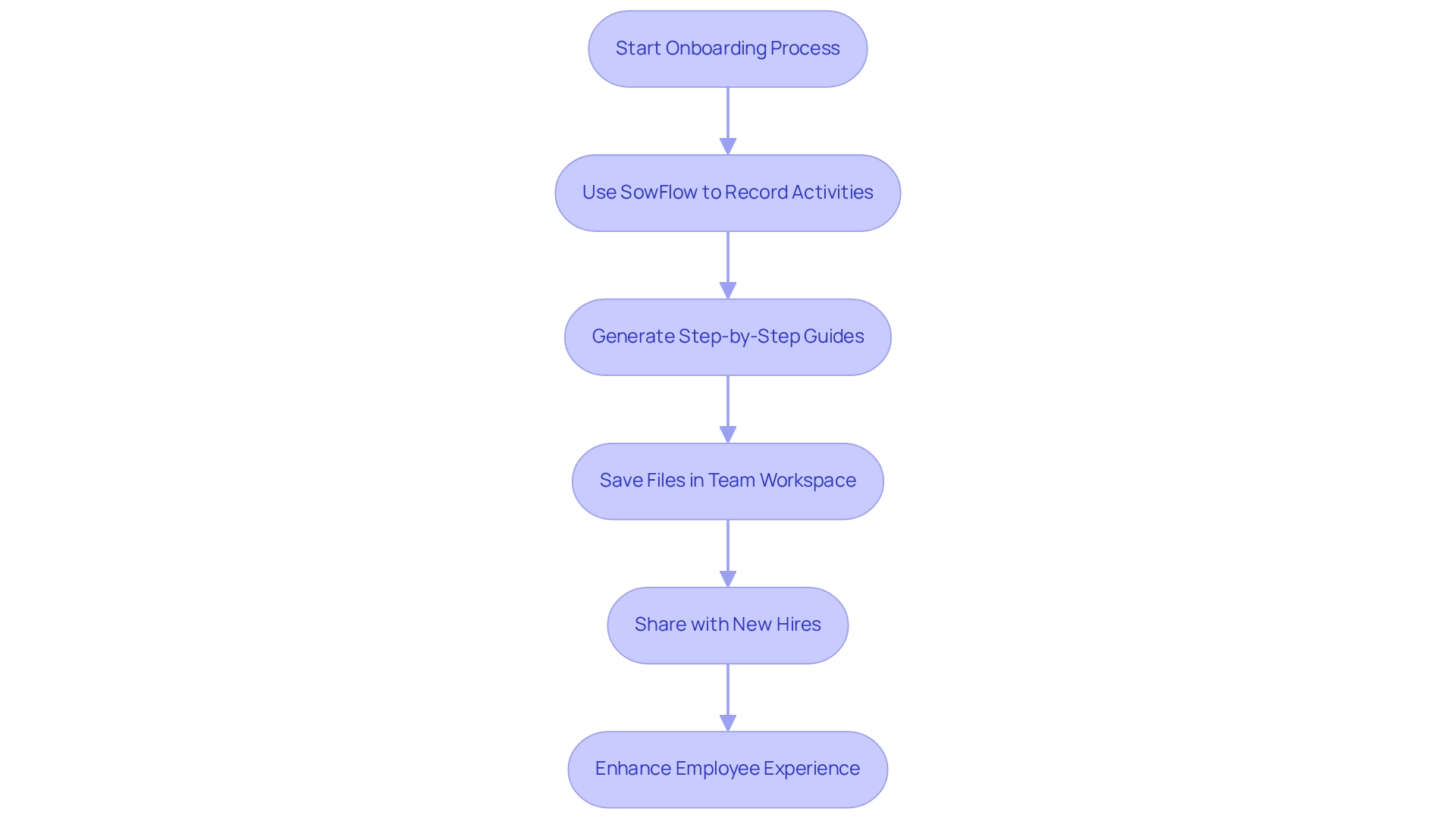
Document360: Comprehensive Knowledge Base for Process Documentation
You might be wondering how Document360 can make your life easier when it comes to managing your organization's knowledge base. Well, let me tell you! This solution is designed to help you create, manage, and share your process documentation example effortlessly. With features like version control, collaborative editing, and an intuitive interface, your team can quickly access the latest information. This centralized approach really boosts knowledge sharing, cutting down the time spent hunting for those essential documents.
And here’s a fun fact: organizations that use efficient knowledge management systems often see a huge boost in operational effectiveness—some studies even suggest productivity improvements of up to 125% thanks to smarter record-keeping! By addressing common record-keeping challenges, Document360 not only helps teams collaborate smoothly but also fosters a culture of continuous improvement. This leads to more organized and scalable operations.
Now, let’s talk about SowFlow, which offers that helps organizations streamline their processes and keep their records up to date effortlessly. As Pradeepa Somasundaram puts it, "Document360 offers an intuitive knowledge base that streamlines content creation, ensures accessibility, and connects with various applications for seamless workflow management." This really highlights the importance of choosing the right tools for effective knowledge management.
Plus, a case study on Document360 shows how it revolutionizes software records by tackling the challenges teams face and enhancing efficiency with advanced tools like Markdown and WYSIWYG editors. By leveraging centralized knowledge management systems, both Document360 and SowFlow can boost operational efficiency and create a more structured way to handle information. So, why not explore these solutions and see how they can transform your documentation process?
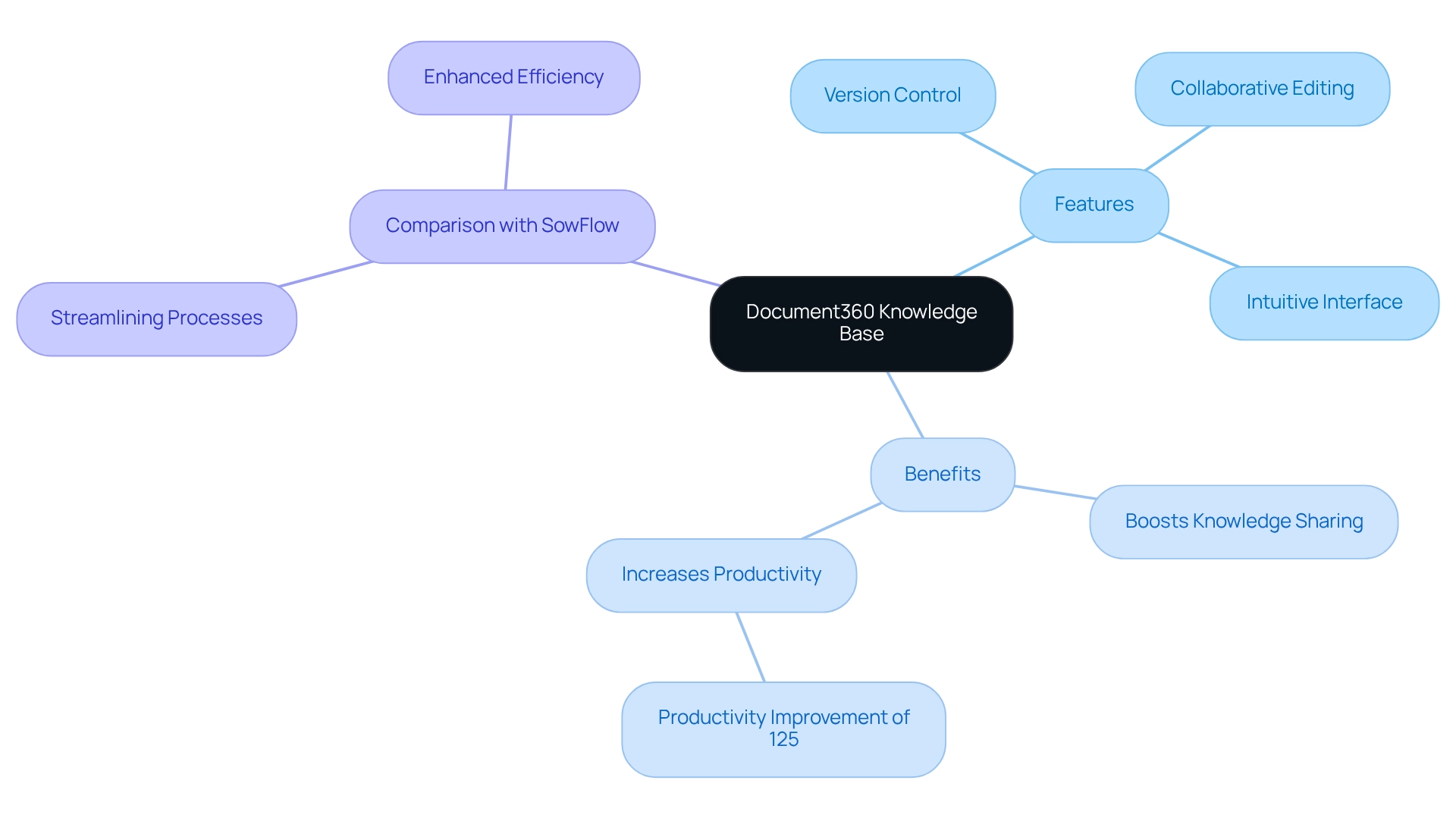
Whatfix: Digital Adoption Tools for Effective Process Documentation
You might be wondering how digital adoption resources can really make a difference in developing an effective process documentation example that meets user needs. Well, these resources are pretty amazing! By providing in-app assistance and situational support, they empower employees to navigate new procedures and technologies with ease. This approach not only boosts user engagement but also encourages everyone to stick to established protocols, ensuring that all team members can accurately follow recorded procedures, which serves as a process documentation example.
Now, let’s dive into how organizations can leverage these resources to enhance their training initiatives. By doing so, they can cut down on the time and resources spent on onboarding and process compliance. As industries shift towards digital-first strategies—did you know that 50% of employees will need significant reskilling by 2025?—the importance of these resources for ensuring smooth transitions and maintaining operational efficiency is huge.
Take the healthcare sector, for example. It’s been making strides toward digital-first strategies, and we’re seeing a remarkable increase in the use of digital resources. The worldwide market for healthcare chatbots is expected to increase from $122 million in 2018 to an impressive $314.3 million! This trend really highlights are for improving workflow records and training.
But here’s the kicker: less than 50% of corporate strategies currently recognize data and analytics as vital for delivering enterprise value, according to Gartner. This really underscores the need for data-driven approaches in record-keeping.
So, what can you do about it? Let’s explore some solutions together!
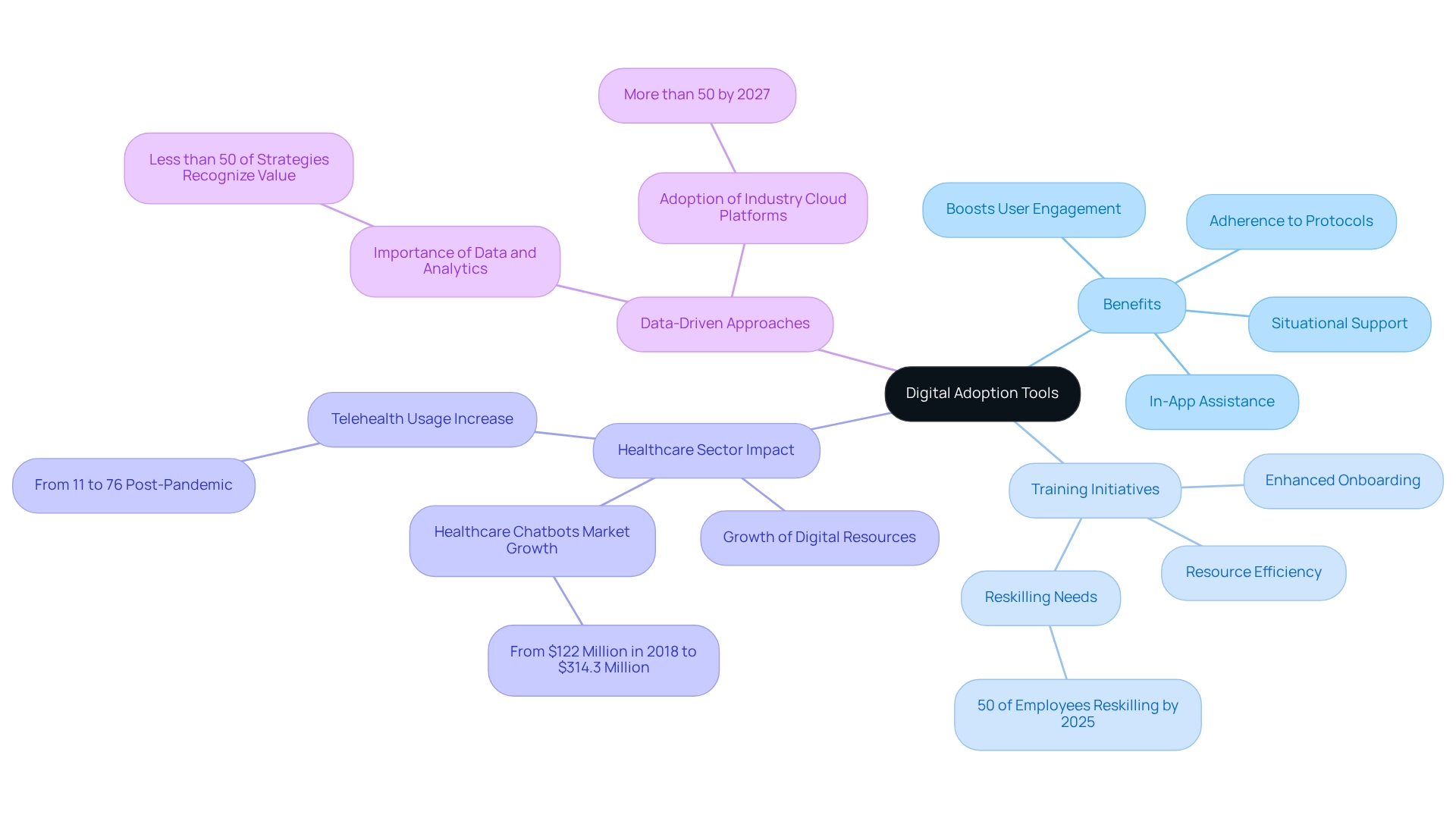
Lucidchart: Flowchart and Diagramming Tool for Process Visualization
You might be wondering how a tool like Lucidchart can really make a difference in your team's workflow. Well, let me tell you! Lucidchart is a powerful flowchart and diagramming application that helps groups visualize their workflows clearly and precisely. By allowing the creation of flowcharts, organizational charts, and various diagrams, it turns complex workflows into easy-to-follow steps. This visual representation not only boosts understanding but also enhances communication among team members, making sure everyone is on the same page.
Now, let's talk about the impact of visual documentation on team dynamics. Organizations using Lucidchart have reported a noticeable uptick in efficiency when it comes to creating . For instance, in manufacturing settings, flowcharts made with Lucidchart have been key in identifying bottlenecks and ensuring compliance with quality management standards. This is super important because effective visualization can lead to improved operational efficiency and ongoing enhancements. Did you know that around 70% of organizations using flowchart tools like Lucidchart see a significant boost in their ability to create a process documentation example and understand workflows? By leveraging Lucidchart, teams can navigate complex workflows more smoothly, which ultimately leads to better outcomes and streamlined operations. Plus, workflow diagrams are vital in quality management, helping to spot failure points and implement preventive measures. This really underscores how significant Lucidchart is for achieving operational excellence. So, what are you waiting for? Dive in and see how it can transform your team's workflow!
Asana: Project Management Tool for Workflow Documentation
You might be wondering how Asana can help your team manage projects more effectively. Well, it’s a powerful project management tool that serves as a process documentation example, allowing groups to document workflows while keeping track of tasks and deadlines. By kicking off projects and assigning specific responsibilities, teams can gain clarity on who’s doing what and how things are progressing. With key features like task dependencies and progress tracking, everyone stays accountable, knowing their commitments and deadlines. This organized approach not only boosts efficiency but also fosters better collaboration among team members.
Now, let’s dive into why this matters. Did you know that 62% of organizations expect to see more project work? That makes tools like Asana essential for adapting to changing project demands. Its features help teams handle this anticipated growth, ensuring workflows stay organized and efficient. Plus, a whopping 94% of businesses recognize that effective project management is crucial for growth, and Asana is here to support that by providing the resources needed for smooth workflow tracking and accountability.
Speaking of support, investment in project management training has jumped by 18%. This highlights are for project success. Asana steps up to meet this need by equipping teams with the tools to enhance their project management skills. And let’s not forget about the hybrid project delivery method, which blends Waterfall and Agile practices—Asana can handle that with ease, showcasing its flexibility in workflow management. For operations managers looking to optimize their workflow records, a process documentation example featuring Asana’s tools could bring significant benefits in task management and team accountability.
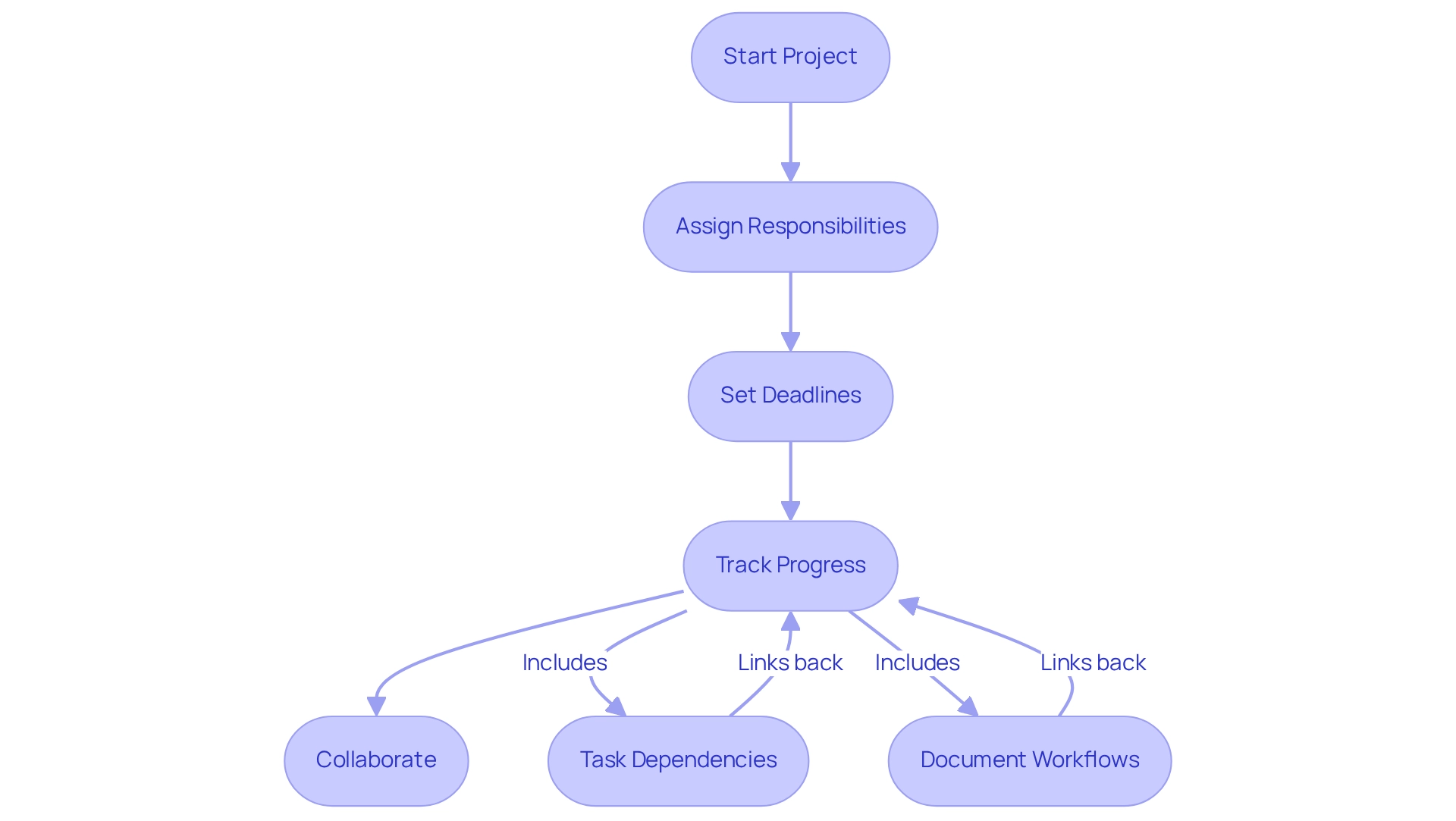
Trello: Visual Workflow Management for Process Documentation
You might be wondering how to keep your team's tasks organized and flowing smoothly. Well, Trello is here to help! It’s a fantastic visual workflow management tool that uses boards, lists, and cards to help groups like yours arrange activities efficiently. You can create individual cards for each task, moving them through different stages until they’re completed. This gives everyone a clear view of how things are progressing.
But wait, there’s more! This visual approach not only makes process documentation easier but also boosts collaboration and accountability among team members. Imagine everyone on your team being aligned and knowing exactly what their responsibilities are. As puts it, 'Trello excels at turning complex technical topics into engaging, people-focused narratives.' It really does simplify those intricate workflows!
Now, let’s dive into some numbers. A recent case study titled 'Future of Project Management' revealed that 90% of organizations undergoing digital transformations are focusing on project management to navigate business changes. This highlights just how crucial tools like Trello are for adapting to these shifts. And with updates rolling out in 2025, Trello is continually improving, offering features that serve as a process documentation example, making record-keeping even simpler and enhancing overall efficiency. This underscores the importance of resources like Trello in boosting team capabilities and fostering effective leadership that supports cross-functional collaboration. So, why not give Trello a try and see how it can transform your workflow?
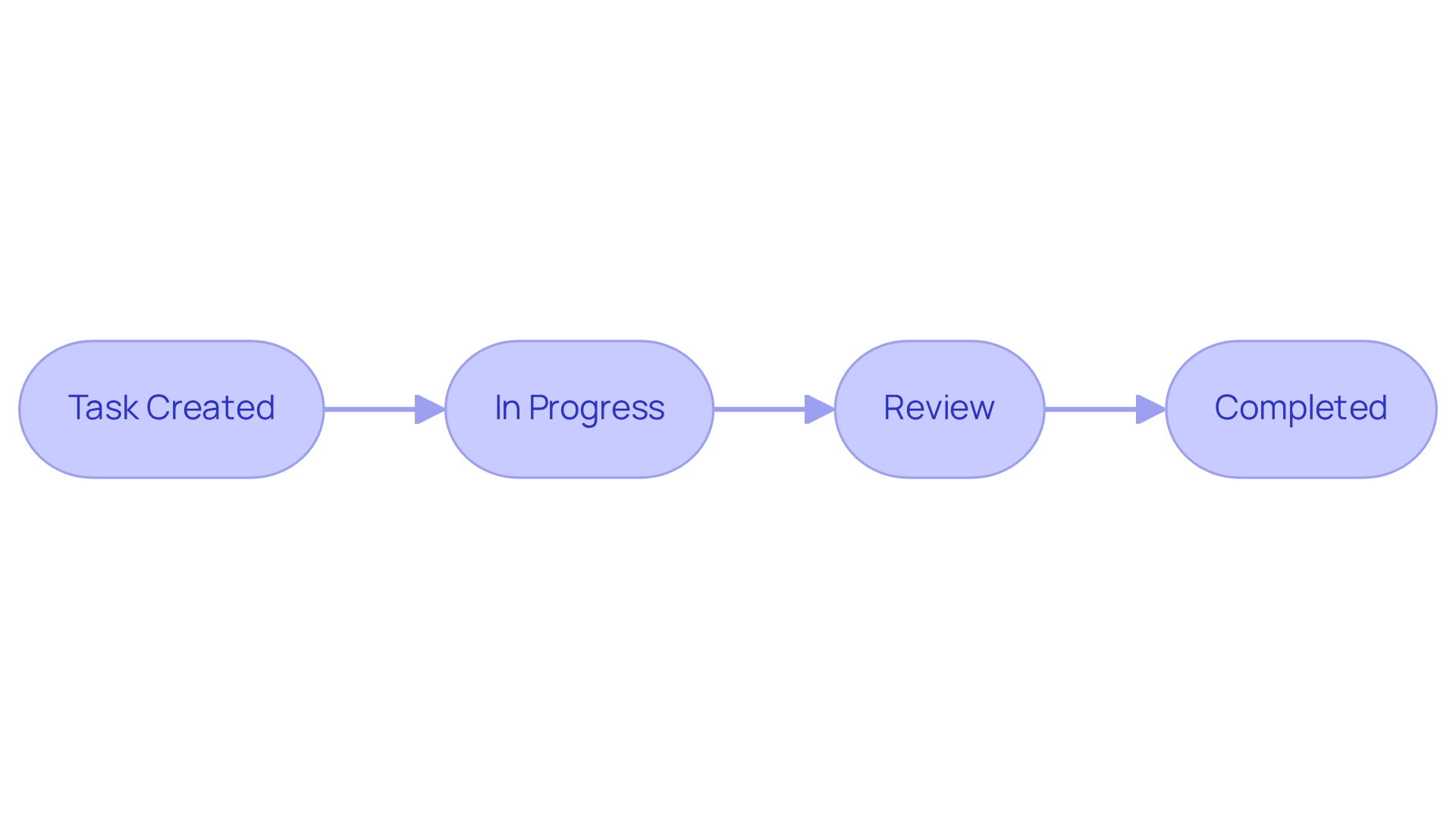
Confluence: Collaborative Documentation Tool for Teams
You might be wondering how to make your record-keeping process more efficient. Well, Confluence is here to help! It’s a fantastic collaborative tool that lets you create, share, and manage records in real-time. With features like inline comments, version history, and collaborative editing, it really fosters teamwork and transparency. If your organization is looking to optimize record-keeping, this platform is a game-changer, allowing everyone to contribute their expertise seamlessly.
Now, let’s dive into how Confluence pairs perfectly with SowFlow. This combo takes your record-keeping experience to the next level. SowFlow makes it super easy to create user guides and keeps your materials fresh and relevant in today’s fast-paced business world. Imagine having all the knowledge from your records at your fingertips—no more unnecessary meetings, just pure productivity!
Organizations that embrace tools like Confluence and SowFlow have seen some impressive results. In fact, many have reported a 50% increase in customer satisfaction thanks to better teamwork and record-keeping practices. And with 73% of companies adopting a hybrid cloud strategy in 2023, the flexibility and resilience offered by these tools are more crucial than ever. Real-time collaboration not only enhances teamwork but also boosts the accuracy of your records, helping teams respond quickly to changing business needs.
Plus, the ease of updating and refining records with SowFlow allows Operations Managers to keep their workflows relevant and efficient. So, why not explore how these tools can transform your process documentation example? It’s all about making your work life easier and more productive!
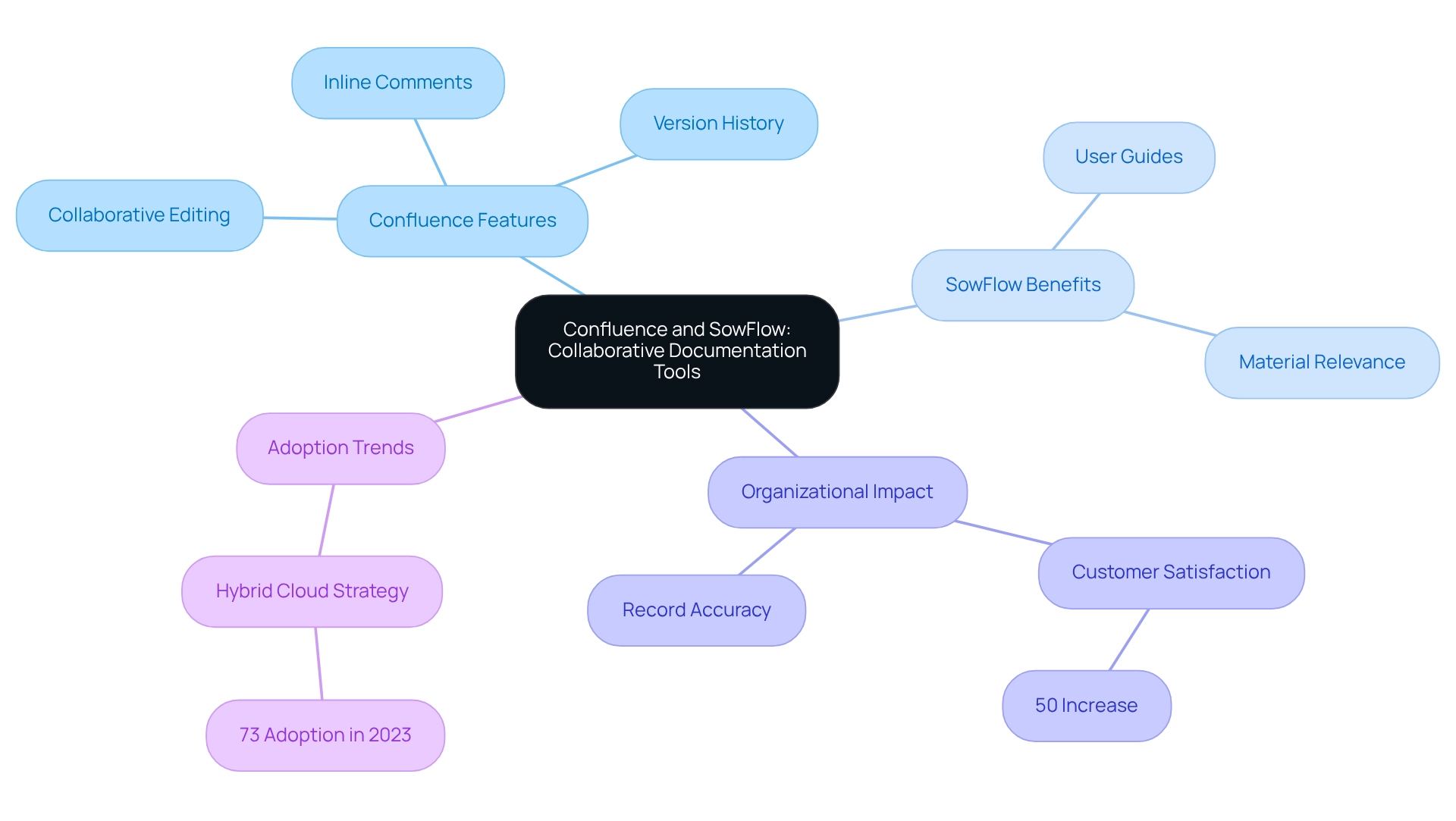
Notion: Flexible Documentation and Project Management Tool
You might be wondering how to make documenting work a breeze. Well, SowFlow is here to change the game! This browser-based tool lets you create Standard Operating Procedures (SOPs) and training materials without the hassle of taking separate screenshots or leaving your browser. Talk about a productivity boost! According to Anastasia Masadi, a Product Owner, 'SowFlow has revolutionized our approach to documenting work and providing services to our clients.' SowFlow has restored some of my time. With SowFlow, teams can easily improve their record-keeping processes, ensuring everyone has access to the latest information while promoting collaboration.
like SowFlow are crucial for operational efficiency. They help organizations keep organized and accessible records. By using SowFlow, you can enhance your process documentation example, which will lead to better productivity and smoother operations. This shift creates a more organized approach to managing information and supports a culture of continuous improvement and adaptability in the workplace. So, why not give it a try and see how it can transform ?
Conclusion
You might be wondering how modern documentation tools can really make a difference in your day-to-day operations. Well, exploring these tools shows just how pivotal they are for boosting operational efficiency and team collaboration. Take SowFlow, for instance. It shines with its ability to whip up comprehensive process documents in no time, tackling the pesky issue of scattered information that often gets in the way of productivity. By streamlining workflows and making critical data more accessible, organizations can really ramp up their performance and cut down on the time wasted on traditional documentation methods.
Now, let’s talk about Miro and Lucidchart. These tools take visual collaboration to the next level, letting teams map out and visualize processes like pros. Not only do they simplify complex information, but they also create a collaborative atmosphere where everyone can pitch in. Similarly, platforms like Document360 and Confluence are fantastic for sharing knowledge and collaborating in real time, ensuring that your documentation is always fresh and easy to find.
And we can’t forget about Asana and Trello! These handy project management tools help teams keep track of tasks and stay accountable, which is super important in today’s fast-paced work environment. Plus, with the rise of digital adoption tools, effective training and user engagement have never been more crucial, especially as organizations shift toward digital-first strategies.
In a nutshell, the explosion of innovative documentation solutions is changing the game for teams everywhere. It’s becoming essential for organizations to embrace user-friendly tools that not only boost productivity but also enhance collaboration. By adopting these technologies, you’re not just streamlining processes; you’re also fostering a culture of continuous improvement that sets your team up for success in a competitive business landscape. So why not dive in and explore these tools further? You might just find the perfect fit for your team!
Frequently Asked Questions
What is SowFlow and how does it help businesses?
SowFlow is a tool that transforms the way businesses generate process documentation examples. It features an intuitive interface and advanced technology, allowing teams to easily map workflows and standard operating procedures (SOPs), which enhances knowledge management and keeps records precise and up-to-date.
What challenges does SowFlow address in documentation?
SowFlow addresses the chaos caused by fragmented data, which 42% of staff struggle with when finding and sharing information. It provides efficient record-keeping solutions, reducing time-consuming methods and improving overall documentation processes.
How does SowFlow contribute to productivity?
By streamlining communication and reducing the need for excessive meetings and emails, SowFlow can significantly boost team productivity. It offers economical solutions that help companies transition to paperless environments, which is essential for operational efficiency.
What role does generative AI play in SowFlow?
Recent advancements in generative AI allow SowFlow to quickly train custom document models, helping businesses adapt to specific needs on the fly, making it highly relevant in today’s fast-paced environment.
What is Miro and how does it facilitate collaboration?
Miro is a visual collaboration platform that allows teams to create intricate process documentation examples and diagrams. Its user-friendly interface enables real-time brainstorming and visualization of workflows, enhancing collective work efforts.
How does Miro improve employee engagement during meetings?
Miro addresses the dissatisfaction that 98% of employees feel with video meetings by providing effective collaboration tools that boost record-keeping processes, making complex information easier to understand and encouraging active participation.
Why is Miro important for inter-departmental collaboration?
Miro promotes effective communication and coordination across different functions, which is crucial since 41% of employees find it more challenging to collaborate across departments than within their own teams.
How does SowFlow enhance the onboarding process for new employees?
SowFlow provides a process documentation example for creating step-by-step guides, automatically recording activities in real-time. This speeds up onboarding and ensures new hires have immediate access to essential information, improving their experience from day one.
What benefits does SowFlow offer during the onboarding process?
SowFlow boosts onboarding efficiency by saving files in a team workspace for easy access, allowing for effective sharing of workflows. It also enhances the overall employee experience during training with intuitive guidance solutions.
👍
What others are liking
5 Steps to outline your ideal documentation structure
5 MINS READ
Where to start the your journey of mapping out your ideal documentation structure, aligning it with the very heartbeat of your organization?
Defining a winning level of detail in your process
3 MINS READ
What is too much detail, and what is too little? This article described in that winning level detail about what detail is enough.





